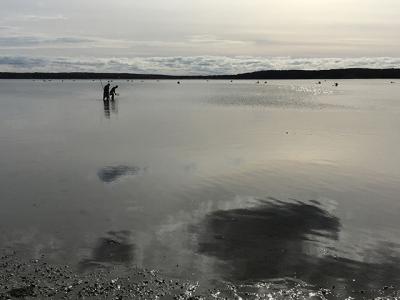Scallops on November Menu

The East Hampton Town Trustees have set Nov. 11 as the opening date on which scallops can be taken from waters under their jurisdiction.
New York State announced Nov. 5 as the opening of scallop season in state waters. The trustees typically open waters a week later to allow additional time for scallops to spawn. The season will end on March 31, 2019.
Last year, the trustees opened waters under their jurisdiction on a Sunday, when use of a dredge or other powered device is prohibited. The idea, said Francis Bock, the trustees’ clerk, was to allow everyone an opportunity to harvest the hotly anticipated delicacy. “I think it was an overwhelming success,” Mr. Bock told his colleagues at a meeting on Friday. “I still hear a lot of feedback.”
“It was a great day on the water,” said Rick Drew, “like a scallop festival.” With that in mind, they voted unanimously to open the waters on Nov. 11, a Sunday.
The town’s shellfish ordinance sets a daily limit of five bushels per day for commercial licensees. Two or more people holding commercial permits and occupying the same boat may take in the aggregate up to 10 bushels per day. “Two or more persons, only one of whom holds commercial permit and occupying the same boat while taking escallops, may take in the aggregate not more than five bushels in one day,” the ordinance reads.
Those with noncommercial licenses are allowed one bushel per day; three or more such persons occupying the same boat may not take in the aggregate more than three bushels per day. Bushel bags are sold, for $1, in the trustees’ office at the Lamb Building on Bluff Road in Amagansett.
The consensus last year was a modest rebound in the population of bay scallops, New York’s official state shellfish, after two consecutive years of disappointment. In recent years, the population has been impacted by factors including blooms of rust tide (cochlodinium). While not injurious to humans, rust tide can be harmful to shellfish and finfish. Predation by marine life including crabs and conchs has also hurt, and is worsened by sparse habitat such as eelgrass. Warmer water temperatures may also contribute to the falloff.
The town’s shellfish hatchery, which was established in the wake of algal blooms that decimated shellfish populations in the 1980s, seeds local waters with scallops, oysters, and clams.
